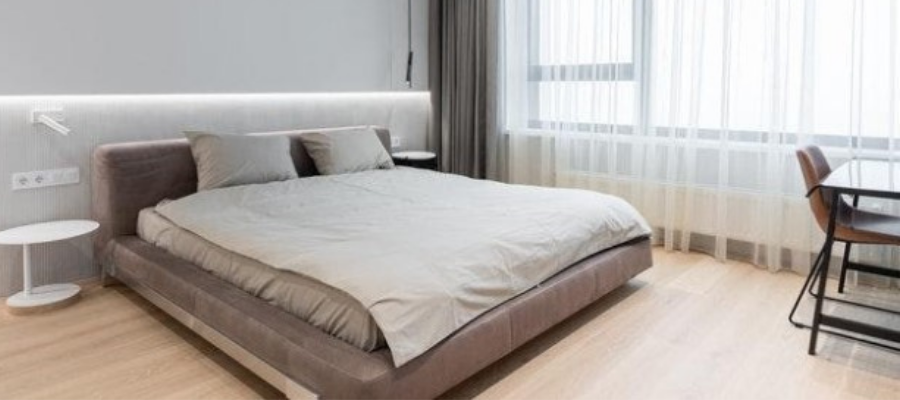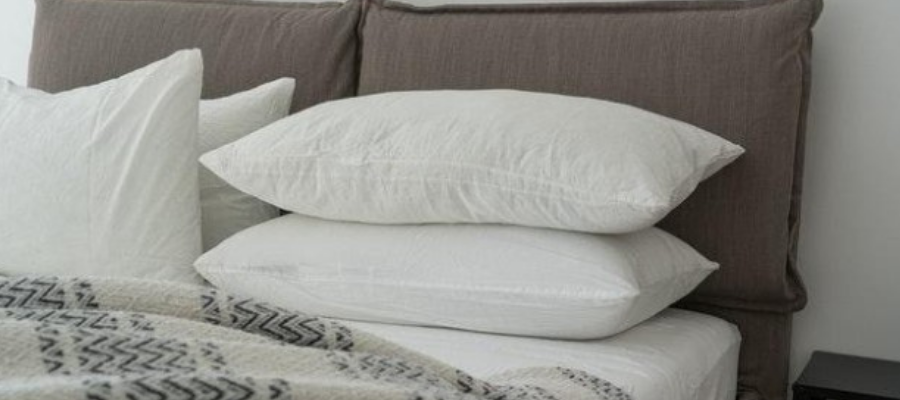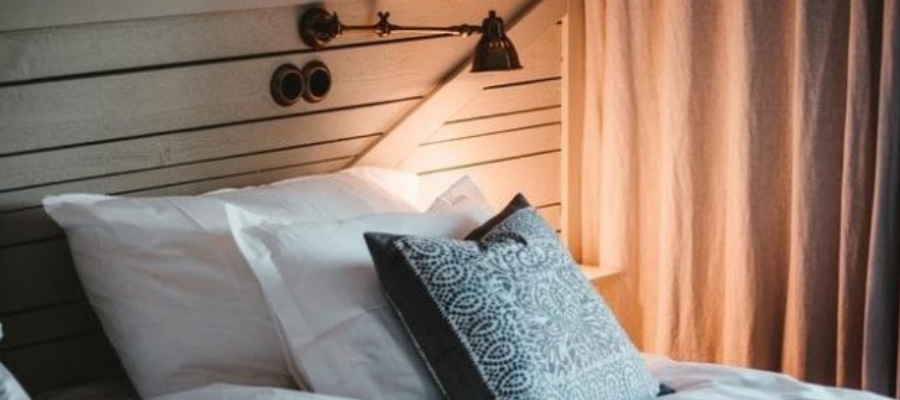The essential guide to creating the perfect bedroom to sleep like a rock
We have all felt the immediate benefits of a good night's sleep, right? We feel clearer, more energized, and better able to handle the day-to-day stressors of life. No wonder our days are better when we have more sleep! Here we give you the tools to creating the perfect bedroom to get rejuvenating sleep every night.
A healthy brain makes better decisions, and the chain reaction goes from there. Let’s talk about what that chain reaction looks like by the numbers:
- Sleep deprivation for most people is classified as getting less than 7 hours of sleep per night.
- Sleep deprivation is linked to a number of adverse effects, such as decreased cognitive abilities, depression, and heart diseases.
- 1 in 3 adults in the US don’t get enough sleep.
- Acute insomnia is characterized by difficulty falling asleep or disrupted sleep lasting from a few days to a month.
- 30-40% of the US adult population suffers from occasional insomnia, making it the most common sleep disorder.
The importance of sleep doesn’t stop with your brain, either. Sleep also allows your body to rest and, in doing that, helps to prevent diseases. Healthy bodies and healthy minds start with sleep, so let’s talk about ways you can ensure that your sleep habits and bedroom are setting you up for excellent sleep hygiene.
Mattress

Choosing a mattress is not only crucial to the health of your mind and body but to your wallet, too. Mattresses are expensive investments that will ideally be with you for many years, so choosing the right one for you is a critical component of the perfect bedroom.
There are three main types of mattresses: innerspring, latex, and memory foam. Each has its own advantages depending on what’s important to you and what your sleep habits are.
Innerspring – This type of mattress is the traditional choice. Coils made of different metals make up the core of these products and are wrapped in a softer material for comfort. The lifespan of these mattresses is typically quite long since they are durable and can stand up to multiple moves, etc.
Innerspring mattresses transfer motion more readily than a material like memory foam, so if you share your bed with a partner that’s prone to tossing and turning in the night, you might want to consider a mattress with fewer motion transfer properties. Additionally, if you’re a side sleeper, you might find more pressure points on your shoulders, hips, and knees with this type of mattress. Even though the coils are covered and padded, the mattress’s core still contains coils and can create uncomfortable pressure points if you don’t sleep on your back.
Latex – Latex mattresses are currently the least common but do provide several advantages to consider. Latex is made from natural materials and is healthier than synthetic options that come with off-gassing and potential odor. It’s responsive, has a more characteristic mattress-like bouncy quality, and is more cooling than synthetic materials like memory foam.
Memory Foam – This type of mattress has seen a huge surge in popularity over the past several years. This stems from its comfort, cost-effectiveness, and online availability. Memory foam was initially engineered by NASA as a material to protect astronauts in the case of a crash landing, so you can imagine that it would be pretty comfy for your nightly sleep, too.
Memory foam is especially good at reducing motion transfer and providing full-body support, particularly for side sleepers. A potential downside is that it retains heat, although there have been several companies working on innovations to address this concern in recent years.
Sheets

If you’re not a sheet connoisseur yet, just wait. To the novice eye, bed linens may seem like a straightforward topic, but there is much to delve into, and once you experience good sheets, you’ll never want to go back!
One of the primary considerations to take into account when choosing the best sheets for you is the weather in your location, as well as the time of year. Flannel sheets may be cozy as all get out, but if you’re living in Arizona, they’re probably not the right choice for you in July. Likewise, bamboo sheets are touted for their sustainability and also their cooling effect, so think about that if you’re buying sheets during December in Montana.
Cotton is the most common natural fiber used in making high-quality bed linens, but there has been a rise in the popularity of bamboo sheets in recent years. Bamboo is very soft and often has a sateen-like feel, so if you’re a fan of silky feeling sheets, bamboo might be a great choice for you.
Synthetic sheets are mainly made of polyester with different types of textile techniques used to create a sateen finish or microfibre sheets. Synthetic sheets are remarkable for durability and stain resistance but tend to hold heat and feel less luxurious than cotton sheets.
Egyptian cotton is well known for being “the best” cotton globally, and there are a few reasons why it boasts that illustrious reputation. Egyptian cotton is picked by hand, which is gentler on the fibers than machine picking and results in long strands of fibers. Longer fibers allow the cotton to be woven into very fine fabric without sacrificing strength. What that gives you are sheets that are lightweight, strong, and soft.
Thread count is one of the most common ways that bed linen manufacturers try to convey quality – but it isn’t always indicative of how your sheets will feel. The more important factor is fiber length. Longer fibers will create softer sheets but are also more expensive due to the increased care required in the harvesting and spinning processes. A 200 thread count fabric made from a high-quality fiber like Supima cotton will feel softer than a 1,000 thread count fabric made from low-end cotton.
Pillows

If you’ve ever slept funny and had a sore neck, you understand how important a good pillow is. There are some key categories of pillows, including those for back sleepers, stomach sleepers, and side sleepers. The ideal pillow keeps your spine in an aligned and neutral position while you sleep, and much of that comes down to thickness.
Back Sleepers – Look for medium thickness in a pillow. Your neck naturally curves up towards the base of your skull and requires some fullness to support, but not so much so that your chin is pushed towards your chest.
Side Sleepers – Big fluffy pillows are a side sleeper’s friend. Due to the amount of space created between your shoulder and your neck, side sleepers need more fullness to support their necks from the side.
Stomach Sleepers – You’ve probably already heard that it’s tough on your neck and back to sleep on your stomach, but if you haven’t been able to break that habit, look for a thinner pillow that doesn’t prop your head back too far. (And maybe try to train yourself to sleep in a different position – your future self will thank you!)
What the best pillow for you is made of will also vary based on your personal preference and preferred sleeping position. Down is one of the most common fillers for pillows and tends to be on the more expensive end of the price range. Other natural materials like cotton are also common options that can be good alternatives if you’re allergic to down. Synthetic fill material like polyester is typically much more inexpensive than down but won’t last as long; it will continue to compact over time, unlike a down pillow that can be continually fluffed up again.
Comforters
If a comforter is something you’ve taken for granted but never really considered the part it plays in your good night’s sleep, buckle up. Comforters, like sheets and pillows, can dramatically improve your sleep quality.
The technical details and materials of comforters are similar to pillows. Down comforters are more costly but last much longer, whereas synthetic-fill comforters are typically cheaper.
The temperature comes into play more with comforters than pillows, however. Synthetic comforters can be great options for summertime when you want something cooler and lighter, whereas a fluffy down comforter is cozy and snuggly in chillier months.
A new innovation in comforters to consider is the weighted comforter. These products are made to be soothing and calming, helping you drift off to sleep faster and have higher quality sleep.
Eye Masks

If you haven’t tried sleeping with an eye mask before, you owe it to yourself to give it a try. If you’ve only tried one type and it wasn’t for you, you owe it to yourself to try the other types. You might just find the perfect Goldilocks sleep mask.
Flat Eye Masks – A flat eye mask is what most people will picture when thinking of a traditional eye mask. A light, thin design is comfortable to wear as long as you don’t mind slight pressure on your eyes.
Molded Eye Masks – If you’ve found that the pressure on your eyes bothers you, look into these cupped eye masks that have space around your eyes specifically to avoid that discomfort.
Weighted Eye Masks – Conversely, other eye masks rely on that pressure in a positive way and use beads similar to those found in weighted blankets to soothe and improve sleep.
VIEW ALSO: Propeaq light therapy glasses
White Noise Machines
What is a white noise machine? Controversy, if you’re in opposite camps as your partner. We jest (mostly). White noise machines can be an effective way to create a soothingly consistent sound environment. If you live in an urban environment, you might find that your sleep is disturbed by traffic sounds, car horns, or passersby. The unobtrusive design of these small bedside sound machines can be a great way to filter out those irritating noises.
Sound machines have become more and more common, but have been around for longer than you might think! One of the best-selling sound machines on the market today was invented in 1962!
There are various types that can include light and aromatherapy based on your personal preferences, so take some time to browse the different combinations to make sure you find the best option for you.
Earplugs
Sleeping with earplugs brings to mind the classic trope of a snoring partner or never-ceasing construction noise, but it can also be a great way to increase the quality of your sleep even if you don’t have something specific to block out.
Earplugs are made of foam, cotton, or silicone and typically come in different sizes and shapes to fit your ear canal or ear opening. Foam and silicone earplugs fit inside your ear canal and are excellent at blocking out noise. Wax earplugs are different because they mold to the outside of your ear opening and do not sit inside your ear canal. Wax earplugs can be a great option if you find earplugs that fit inside your ear to be uncomfortable.
Whichever style of earplugs works best for you, you’ll need to make sure you’re using them right. This comes down to fit. Ensuring that your earplugs are creating a proper seal is key to getting the noise blocking benefits that you’ll need to improve your sleep.
Extra Gadgets & Tips for the perfect bedroom

We focus a lot on sleep, for a good reason! That’s good for you because it means that many very smart people are coming up with new and innovative products to improve your sleep.
Humidifiers – Improving your breathing can dramatically help to boost the quality of your sleep, and a humidifier can be a great way to do that. If you live in a dry climate or somewhere with harsh winters that require constant furnace heating, likely the air in your home gets dry. Try out one of these bedside humidifiers to breathe easier at night.
Lights – Having soft and gentle lighting in your bedroom can help create a calming space. Additionally, a sunrise alarm clock uses light to gently lift you out of sleep without using the typical jarring alarm clock sound.
Scents – Candles are lovely, but not when you’re sleeping! This is where the aromatherapy diffuser comes to the rescue. Widely available at different price points, these handy little gadgets are often made with built-in timers so that you can turn them on at bedtime and not worry about having to turn them off again.
Thanks for reading
Armed with the info included here, you’re well on your way to creating the perfect bedroom to have the best sleep and enjoying the health benefits and improved quality of life that comes with that.
While you’re at it, why not have a look at our innovative solutions to improve rest at the workplace, or explore more about the benefits of power napping?

